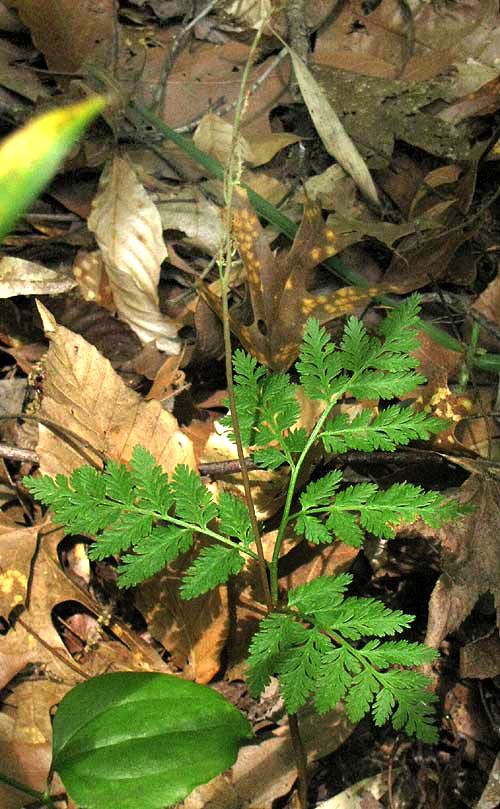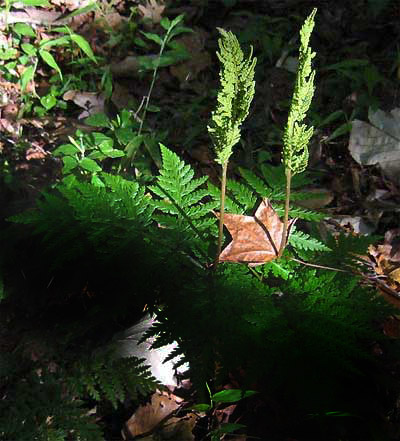Excerpts from Jim Conrad's
Naturalist Newsletter
from the May 6, 2012 Newsletter issued from the woods of the Loess Hill Region a few miles east of Natchez, Mississippi, USA
RATTLESNAKE FERN

Above you see one of the easiest to identify and widely distributed ferns. It's found almost worldwide except in the coldest, driest and tropical parts. It's the Rattlesnake Fern, BOTRYPUS VIRGINIANUM.
What makes the species so easy to identify is its triangular frond divided three to four times into cut-margined leaflets, and the slender, pale, sky-pointing item arising at the center of the frond's base, which is the spore-producing part, the sporophore. Ours is a bit past its prime. Sometimes the top of a Rattlesnake Fern's sporophore looks a little like an old rattlesnake's tail sticking into the air. You can see one we found in southern Mexico with a snakier sporophore in the entry below.
Sometimes the sporophores bend to one side. When I was a kid in Kentucky I was told that such bent sporophores pointed toward rattlesnake nests. That's the kind of story that got me to doubting a lot of things people were telling me in those days.
A University of Michigan medicinal plant database reports that the Cherokee made a decoction of Rattlesnake Fern root which they boiled down to a syrup, which they rubbed on snakebites. The Chippewa made a poultice of the fern's freshly mashed root for the same purpose. The Ojibwa said the plant was good for lung trouble and tuberculosis. However, none of these uses have been confirmed, and one suspects the snakebite cure arises from the "Doctrine of Signitures," which rests on the superstitious assumption that plants signal to us how we should use them. Thus the Rattlesnake Fern's sporophore similarity to a rattlesnake tail signals that it's good for snakebite.
from the January 14, 2008 Newsletter issued from Yerba Buena Hospital Clinic just outside Pueblo Nuevo Solistahuacan, highland Chiapas, MEXICO
RATTLESNAKE FERNS
We don't have rattlesnakes here but we do have rattlesnake ferns, two of whom you can see below:

The fronds in that picture are about 15 inches high, triangular in shape, and are first divided into three subsections, then those subsections are divided once or twice again. The dried leaf atop one frond is from a Sweetgum.
I've heard two explanations for their being called rattlesnake ferns. One is that their spore-producing spikes point skyward the way an upset rattlesnake's rattle might. The other is that those same spikes often are held bent to one side, pointing toward the nearest rattlesnake nest. Whatever the case, this fern has nothing to do with rattlesnakes. It's just a primitive form of fern with a curious way of presenting its spore-producing spikes, and as such it's always a pleasure to find.
The only rattlesnake fern listed for Yerba Buena is Botrychium decompositum (Botrychium is an earlier name for Botrypus), but the ferns I'm seeing look like North America's common rattlesnake fern, Botrypus virginiana, which also occurs in Mexico, Central and South America, as well as Eurasia. Since so many North American species are surviving in our "sky island" of relict organisms left over from the last ice age, I'm betting that our fern is the same as North America's Botrypus virginiana, or a subspecies thereof.
The fern's erect, stalked, spore-producing spikes are only one of its interesting, primitive features. When you scrape away a little humus from around the fern's base you see that its roots are unusually short and fleshy, like dingy spaghetti.
These unusual features reflect the fact that rattlesnake ferns arose so early in evolutionary history that the fern world hadn't yet "figured out" how to arrange its spore-producing sporangia in the modern manner of having neat little fruit-dots or sori on frond undersurfaces, and neither had they yet discovered how to produce the slender, much-branching, very efficiently absorbing roots typical of modern ferns.